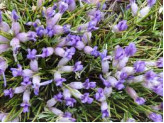Chemical Composition and Antibacterial Activity of the Essential Oil from Erinacea anthyllis Link (Fabaceae)
http://www.doi.org/10.26538/tjnpr/v7i4.4
Keywords:
Algeria, Batna, essential oil, antibacterial, Erinacea anthyllisAbstract
Erinacea species is used in traditional medicine to treat rheumatic diseases. The purpose of this study was to determine for the first time, the chemical composition and antibacterial activity of essential oil from the fresh aerial parts of Erinacia anthyllis belonging to the Fabaceae family. The steam distilled oil was analyzed using gas chromatography techniques (GC-FID and GCMS) using two different stationary phase columns (polar and non polar). Furthermore, antibacterial activity against various gram-positive and negative bacteria was determined by disk diffusion and microdilution. Altogether 44 volatile substances, representing around 98.22% of the essential oil was identified. The major constituentswere phytol (9.26%), tricosane (8.62%). Moreover, essential oil exhibit effect on all bacterial strains. The obtained inhibition zone ranged from 7 mm to 21mm with a highest inhibition zone recorded for Bacillus Sp 21mm).Erinacea anthyllis essential oil has good antimicrobial activity against all tested pathogenic bacteria and may be used as a natural antimicrobial agent in the treatment of many infectious diseases.
References
Ahmad F, Anwar F, Hira S. Review on medicinal importance of Fabaceae family. Pharmacologyonline.2016; 3:151-157.
Doudach S, Slougui N, Rebbas K, Benmkhebi L, Bensouici C, Mehmet N A, Akkal S, Bicha S. First report on phytoconstituents, lc-esi/ms profile and in vitro antioxidant activities of lathyrus latifolius growing in Algeria. IJNES. 2022; 16(3):128-136.
Das S, Sharangi A B, Egbuna C, Jeevanandam J, Ezzat S M, Adetunji C O, Onyeike P C. Health benefits of isoflavones found exclusively of plants of the fabaceae family. J. Funct. Foods. 2020; 473-508.
Ramadhani U P, Chandra B, Rivai H. Overview of phytochemistry and pharmacology of chickpeas (Phaseolus vulgaris). WJPPS.2020; 9(9):442-61.
Saad A M, Sitohy M Z, Ahmed A I, Rabie N A, Amin S A, Aboelenin S M, El-Saadony M T. Biochemical and functional characterization of kidney bean protein alcalasehydrolysates and their preservative action on stored chicken meat. Molecules. 2021; 26(15):4690.
Mosallam F M, El-Sayyad G S, Fathy R M, El-Batal A I. Biomolecules-mediated synthesis of selenium nanoparticles using Aspergillus oryzae fermented Lupin extract and gamma radiation for hindering the growth of some multidrug-resistant bacteria and pathogenic fungi. Microb
pathog. 2018; 122:108-116.
Porras G, Chassagne F, Lyles J T, Marquez L, Dettweiler M, Salam A M, Quave C L. Ethnobotany and the role of plant natural products in antibiotic drug discovery. Chem.Rev.2020; 121(6):3495-3560.
Adanson M. Familles des Plantes. II partie. (Ed). Vincent, Paris, France; 1763; 1-640.
Maire R. Flore de l'Afrique du Nord., (Ed). Le chevalier, Paris ; 16:1952-1987
Birouk A, Consultant national en biodiversité et ressources phytogénétiques.Projet FAO / TCP/ MOR/3201,Maroc.2009; 1-34.
Mouffouk S, Marcourt L, Benkhaled M, Boudiaf K, Wolfender JL, Haba H.Two new prenylated isoflavonoids from Erinacea anthyllis with antioxidant and antibacterial activities. NPC. 2017; 12(7):1065-1068.
Adams RP. Identification of essential oil components by gas chromatography/ quadrupolemass spectrometry, Allured Publ., Carol Stream, IL, USA; 2007.
Raho G B, Otsmane M, Sebaa F. Antimicrobial activity of essential oils of Juniperusphoenicea from North Western Algeria. JMB.2017; 1:01-07.
Wiegand I, Hilpert K, Hancock R E. Agar and broth dilution methods to determine the minimal inhibitory concentration (MIC) of antimicrobial substances. Natprotoc. 2008; 3(2):163-175.
Stojanović GS, Lckovski JD, Đorđević AS, Petrović G M, Stepić KD, Palić IR, Stamenković JG. The first report on chemical composition and antimicrobial activity of Artemisia scoparia Waldst et Kit. extracts. NPC, 2020; 15(3) :1-7
Silva RO, Sousa FBM, Damasceno SR, Carvalho NS, Silva VG, Oliveira FRM, Medeiros J V R. Phytol, a diterpene alcohol, inhibits the inflammatory response by reducing cytokine production and oxidative stress. Fundam clin pharmacol. 2014; 28(4): 455-464.
Perera MAD, Qin W, Yandeau‐Nelson M, Fan L, Dixon P, Nikolau BJ. Biological origins of normal‐chain hydrocarbons: a pathway model based on cuticular wax analyses of maize silks. T P J.2010; 64(4):618-632.
Mighri H, Hajlaoui H, Akrout A, Najjaa H, Neffati M. Antimicrobial and antioxidant activities of Artemisia herbaalba essential oil cultivated in Tunisian arid zone. C R Chim. 2010; 13(3): 380-386.
Carvalho MJ, Pimenta FC, Hayashida M, Gir E, Silva AM, Barbosa CP, Canini SRMS, Santiago S. Prevalence of methicillin-resistant and methicillin- susceptible S.aureus in the salvia of health professionals.Clinics.2009; 4:295-302

Published
How to Cite
Issue
Section
License
Copyright (c) 2023 Tropical Journal of Natural Product Research (TJNPR)

This work is licensed under a Creative Commons Attribution-NonCommercial-NoDerivatives 4.0 International License.

















